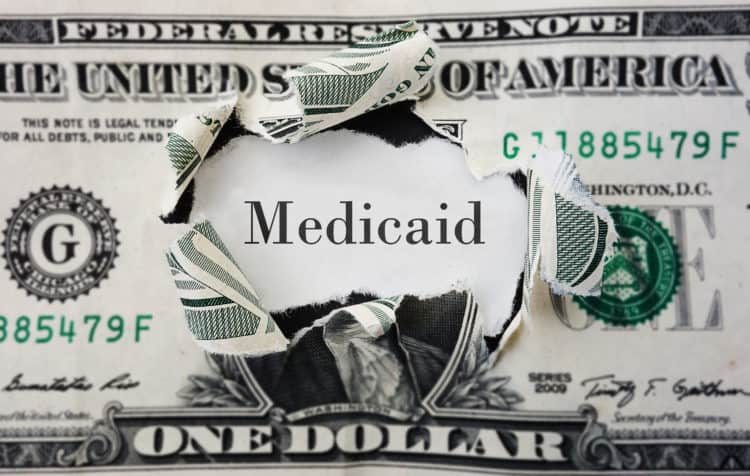
By Dan Murphy
After eight years of good economic news and positive revenue flows for taxes and fees, New York State government faces a budget deficit this year of $6 billion – a number not seen since 2010 when major cuts to local governments and school districts were forced by former Gov. David Patterson.
One of the major reasons for the budget hole is Medicaid spending, which is rising in New York at a rate larger than the 2 percent property tax cap. The budget hole points to a problem: “With the economy and tax receipts still growing in line with projections, for the first time in nearly three decades, New York has an operating deficit not caused by an economic downturn,” said EJ Dione from the Empire Center. “The last time New York ran this deeply in the red without a recessionary excuse was during the 1970s and 80s.”
In 2011, Gov. Andrew Cuomo took office and one of his first actions was to push through a property tax cap, which capped tax increases for local governments, school districts and counties at 2 percent. The tax cap has worked, despite the naysayers – including a few state elected officials from Westchester who voted against it in 2012. The cap has controlled spending to a certain extent, but more importantly it has given the homeowners of Westchester, who pay among the highest property taxes in the country, some certainty about how much their taxes will go up every year.
One of the deals made in 2012 was a property tax cap in exchange for the state taking over the local cost and burden of the Medicaid program. Cuomo and the state agreed to pick up the increased costs every year of Medicaid on county governments, including Westchester.
But in recent years, the yearly increased costs to Medicaid spending have been “unsustainable,” according to Cuomo. So he proposed in his budget plan to push some of the increased costs back to county governments.
Cuomo said local governments, including Westchester County, don’t care about the Medicaid increases because they no longer have to pay the increases. “They don’t have skin in the game because they get a blank check from Albany,” said Cuomo.
The governor has proposed capping the Medicaid increase that the state will pay at 3 percent, and anything above that, county governments would be required to pay themselves. “So they have a financial incentive and a financial disincentive,” he said.
About $77 billion of Cuomo’s proposed $178 billion budget plan is to pay for the Medicaid program. The costs for Medicaid are split between the federal, state and local governments. Last year, Medicaid costs in the state increased by 7 percent, and have been increasing at a yearly rate higher than 2 percent.
While most of Medicaid’s costs are for the poor, some middle-class and upper-middle-class seniors are able to protect their assets through a Medicaid Trust, and then collect the benefits of home care through Medicaid.
Another reason for increased Medicaid costs in New York are the expansion of the Affordable Care Act (Obamacare), which was expanded in NYS through Medicaid. Now, 95 percent of New Yorkers have medical coverage.
Cuomo and the state budget office estimate that $4 billion of the $6 billion shortfall is due to Medicaid.
“We must correct for cost increases incurred when local governments were held harmless by this state for Medicaid increases,” said Cuomo. “We’re paying $177 million on behalf of Erie, $175 million on behalf of Westchester, $2 billion on behalf of the City of New York to cover local costs. It is too easy to write a check when you don’t sign it.”
Budget watchdogs applauded Cuomo for confronting the Medicaid problem, but said it would be a mistake to force local governments to pay a greater share of the costs. New York is one of the few states that compels its local governments to kick in for Medicaid.
Those budget watchdogs said it’s smarter to cut costs because increased spending on items like home care is at the root of the problem. “The state needs to control the costs and not shift the costs to local governments,” said Bill Hammond, a health care analyst with the Empire Center for Public Policy.
Hammond added that there’s a “conflict of interest” because local government officials are less likely to curb costs or deny coverage – possibly angering the powerful health care workers union Local 1199 SEIU, and other health care interests – when they’re not footing the bill
Cuomo has appointed the Medicaid Redesign Team to find cost savings to help balance the state budget, due April 1. Panel co-chairman, Northwell Health CEO Michael Dowling, is hoping to come up with a report next month.
In jeopardy are increases in education funding that usually come every budget year. The NYS Teachers Union has expressed concerns about the budget hole and the impact Medicaid is having on Cuomo’s budget plan.
Other estimates have the increase in the minimum wage to $15 per hour in NYS as a reason for $1.5 billion in Medicaid costs. Long-term care for seniors, whether it be at home or in a nursing home, have also ballooned, from $3.2 billion to $6 billion last decade.
“New York State faces a projected budget gap of $6 billion for the coming fiscal year, in part because of higher Medicaid spending,” said NYS Comptroller Tom DiNapoli. “Over the last four years, my auditors have focused on the Medicaid program, uncovering billions of dollars in waste, fraud and abuse. Our role is to help lower Medicaid program costs by identifying significant cost savings, revenue enhancements and waste.”
The New York State Medicaid program is a federal, state and locally funded program that provides a wide range of health care services to individuals who are economically disadvantaged or have special health care needs. For the state fiscal year that ended March 31, 2019, New York’s Medicaid program had approximately 7.3 million recipients and Medicaid claim costs totaled about $67.4 billion.
Many of the state’s Medicaid recipients are enrolled in MLTC plans. The plans provide long-term care services to people who are chronically ill or disabled. Medicaid pays MLTC plans monthly managed care premiums and, in return, MLTC plans pay for all MLTC covered services.
Under federal law, the Department of Health is required to make a monthly payment (referred to as a “clawback” payment) to the federal government to cover part of the cost of prescription drugs for state residents who are eligible for both Medicare and Medicaid.
“We are concerned about Westchester County having to fund significant additional Medicaid costs – a move that could destroy our budget,” County Executive George Latimer testified in Albany. “Covering this cost will mean that roads, services, and most importantly our taxpayers will suffer… When we first heard of the Medicaid Redesign Team we were eager to be a part of it and work to root out corruption and waste, but I’m concerned about the deadlines this team has and the task in general, as it seems unrealistic to find $2.5 billion in savings by April 1.
“And let’s be very clear, it is unfair to suggest that counties have control over Medicaid rules, extent of benefits and the majority of increase costs. Westchester County is not to blame for rising Medicaid costs. It has been estimated that this could cost counties outside New York City $200 million. Specifically, here in Westchester County, the numbers are alarming.”
Latimer said Westchester would have to pay $5.6 million more in 2021 and $7.8 million more in 2022 in increased Medicaid costs if Westchester County would have to pay a 3 percent local share of increased Medicaid costs, if the growth continues at a 5 percent rate.
“Westchester County cannot afford this,” he said. “The state and federal government set rules for Medicaid eligibility, while New York counties play a role in enrolling and checking the assets of older adults and people with disabilities. We cannot magically keep costs down.
“The bottom line, is our county has an aging population and they are choosing to stay in Westchester and live here. We must help them and protect them. We cannot have cuts impact our most defenseless and we cannot have these cuts bandaged up by local property taxpayers.”
State Budget Director Robert Mujica pointed out that one way or another, the budget will be balanced with changes to Medicaid in New York, either by cutting benefits, capping costs, or having counties like Westchester pay more.
“The Medicaid Redesign Team will bring spending in line with targeted growth while ensuring 6 million New Yorkers maintain the same high quality care they have now,” he said.





